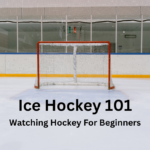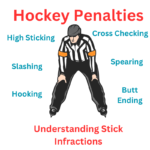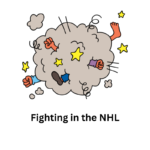Hockey is a fast-paced and physical sport, but within the exhilarating action, there are rules in place to maintain safety and fairness on the ice. Physical infractions are among the most serious penalties in hockey, as they can lead to injury and significantly impact the flow of the game. In this guide, we’ll break down the eight main physical infractions in hockey outlined in the NHL rulebook, explaining each in simple terms

Boarding:
Boarding occurs when a player forcefully pushes an opponent into the boards while they are in a vulnerable position. This can happen from behind or at an angle where the player being checked has limited ability to defend themselves. Boarding is a dangerous play that can result in serious injury, and referees penalize it with minor or major penalties depending on the severity.
Charging:
Charging is when a player takes more than a few steps to accelerate into an opponent before making contact. This often involves excessive speed and force, posing a risk to the safety of the player being hit. Charging penalties are typically called as minor infractions, but referees may escalate to major penalties if the hit is particularly dangerous.
Checking From Behind:
Checking from behind is one of the most strictly enforced rules in hockey, as it poses a significant risk of injury to the player being checked. This infraction occurs when a player hits an opponent from behind, causing them to lose balance and potentially collide dangerously with the boards or ice. Referees penalize checking from behind with major penalties and possible ejection from the game.
Clipping:
Clipping is a low hit aimed at an opponent’s knees or lower body, often with the intention of causing them to fall or lose balance. This type of hit is extremely dangerous, as it can lead to knee injuries and other serious harm. Clipping penalties are considered major infractions and are treated with severity by referees to deter such reckless behavior.
Elbowing:
Elbowing occurs when a player uses their elbow to strike an opponent, either intentionally or recklessly. This can happen during a check or in a confrontation near the boards or in open ice. Elbowing is against the rules because of its potential to cause injury, and referees will penalize it with minor or major penalties depending on the severity of the infraction.
Head-Butting:
Head-butting involves intentionally striking an opponent with one’s head and is one of the most dangerous actions in hockey. Not only does it pose a risk of head injury to both players involved, but it also carries the potential for serious consequences. Referees penalize head-butting with major penalties and possible ejection from the game to ensure the safety of all players on the ice.
Interference:
Interference occurs when a player obstructs or impedes the progress of an opponent who is not in possession of the puck. This can happen away from the play or during a race for the puck, and it disrupts the flow of the game. Interference penalties are called as minor infractions, but repeated offenses can lead to more severe consequences.
Kneeing:
Kneeing is when a player uses their knee to strike an opponent, either intentionally or recklessly. Like clipping, this type of hit targets the lower body and can result in serious knee injuries. Kneeing penalties are considered major infractions, and referees will penalize them accordingly to deter players from engaging in such dangerous behavior.
In conclusion, physical infractions in hockey are serious offenses that can lead to injury and disrupt the integrity of the game. It’s crucial for players to understand and respect the rules regarding physical contact to ensure the safety of themselves and their opponents. By playing within the rules and exercising discipline on the ice, players can enjoy the exhilaration of hockey while minimizing the risk of injury and maintaining fair play.
Thanks for your time. Please leave comments and suggestions below.




